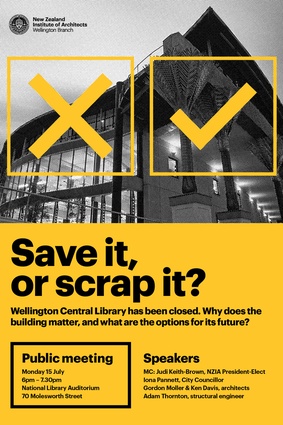Editorial: Chris Barton on longevity
The closure of Wellington’s Central Library in March was bad but by May it got worse, when mayor Justin Lester told Radio New Zealand there was a “reasonable likelihood” the building would be demolished and rebuilt. Distressingly, Lester immediately raised the “opportunity to have a modern library that’s focused on the future”. He also betrayed Tūranga envy, talking about Christchurch’s new central library: “It’s a wonderful space that could be something really exciting for the city.”
To be fair, Lester also said repair was being considered. Depressingly, however, he seemed oblivious to the wonderful space, in the 28-year-old Athfield Architects-designed library, his city already has and unconcerned by what a tragedy to Wellington its demolition would be. The building, a keystone in Te Ngākau Civic Square, is undoubtedly loved for its quirky procession of nīkau palm columns: envoys that lead the way to the library and from the building, across the square and via the City to Sea Bridge. Serious way-finders, but also a perfect representation of the late Sir Ian Athfield having a bit of laugh in the process of establishing a truly iconic architectural sign that’s quintessentially Wellington.
The library is pretty good, too: a pioneer of modern library design as the living room of the city. Prior to its closure, it was being used by some 3000 visitors a day. It is also adaptable enough to change with the times. Indeed, Athfield Architects has been engaged by Wellington Council since 2016 to look at both the square and the library.
The proposed makeover involves replanning the collections over all the floors, providing alternative circulation throughout the building and incorporating new temporary spaces and functions reflecting the ever-changing faces of libraries. The design also sought to give sorely lacking ground-floor activation to Civic Square and Victoria and Harris Streets.
Although the mayor may be unable to appreciate this magnificent architectural legacy, you have to say his decision to close the building was entirely correct. The library’s hollowcore (Dycore) floor units have significant seating issues that, with certain types of earthquake, could be catastrophic.
As one engineer I spoke to put it: “lumps of concrete falling on your head are pretty fatal”. The scenario begins with a few units shaken from their seating, as happened when a couple of double tees came down in Wellington’s Statistics House during the recent Kaikōura earthquake. Then more fall, potentially a shower of flooring units. Then the building’s floors pancake.
The knowledge of hollowcore is recent – a learning from Kaikōura that results in the library’s current rating of between 15 and 25 per cent of the New Building Standard (NBS). Below 34 per cent is earthquake prone: a term which seems grammatically incorrect. Wellington is prone to having earthquakes. A building isn’t. It’s prone to being damaged in an earthquake. Never mind.
What’s not being said enough is that the library isn’t the only building in Wellington to have hollowcore flooring units. Dycore was the flooring of choice in multi-storeyed buildings in Wellington and elsewhere in the early ’80s through to 2000 – so much so that there are hectares of the stuff throughout Wellington. The council is apparently aware of 150–200 hollowcore buildings in the city. Presumably, they all have similar seating flaws and life safety issues. Why haven’t they been closed too?
The good news is that, in many cases, like the library, where the flaw is known as a ‘positive moment failure’, the fix is relatively simple and inexpensive – solved by putting some shelf angles underneath the hollowcore to hold it up and prevent it from slipping off its seating. As a number of engineers have pointed out, it’s already been done and not too expensively on a number of Wellington buildings.
Engineers acknowledge that, potentially, the library may have other problems. The big precast panels facing Victoria Street might be problematic and the floors have large openings, meaning the structural floor diaphragms may be discontinuous. But, again, there is a fix using various forms of bracing and technologies, such as viscous dampers, to stiffen the superstructure and slow down the displacements or reduce the drifts on the building. Engineers point out, too, that, since the building is not that tall and has an existing basement, it is likely to be well suited to remedial base isolation.
The lack of base isolation is Wellington’s elephant in the city, and a question that must be asked of architects and engineers over and over again. Why, when this technology has been available to us for decades, hasn’t it been more widely used? And why wasn’t it insisted upon when the library was designed in 1989?

Thankfully, as Wellington comes to terms with a building insurance crisis stemming from earthquake risk, we are beginning to see more and more new buildings in Wellington using base isolation. It’s encouraging to see an army of architects, engineers and others mobilising to try and save this library and convince Council that repair is better than demolition.
Ultimately, this will be an argument about cost. NZIA Wellington Branch Chair Angela Foster gets to the nub of this issue, noting that removal of the building would not only leave a hole in the city’s heritage but also incur an inevitable environmental cost. As she points out, construction produces nearly 40 per cent of energy-related carbon dioxide emissions and it takes decades for a new building to compensate for the negative climate change effects resulting from its construction.
“This should be of concern to the council,” says Foster. “Why? Because it has just released Te Atakura – First to Zero, its blueprint for ‘a zero-carbon capital city’.”
One hopes such arguments prevail but you have to say it’s a lack of foresight by, among others, architects and engineers, that has brought us to this place. One imagines, in 30 years’ time, we might be facing the same sort of lack-of-foresight questions as Wellington’s waterfront (and, indeed, Auckland’s) begins to deal with the effects of climate change.
The New Zealand Institute of Architects has organised a public meeting to discuss the future of the Wellington Central Library on Monday 15 July at 6pm in the auditorium of the National Library, 70 Molesworth Street. Click here to find out more.
This article first appeared in Architecture New Zealand magazine.












